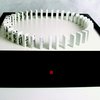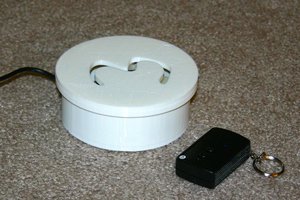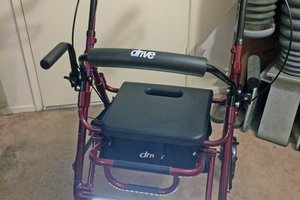I decided to monitor the switch continuously (instead of using an interrupt) since AC would be close by (see the ceiling photo with duplex outlet); so, power consumption wasn't an issue. On the other hand, the remote requires 12V, normally supplied from a weird, little 12V battery. That battery lasts a long time, but not forever, and someday would need replacing, regardless of how infrequently it's called upon to close the forgotten door. I wanted the box with the remote, Trinket, etc. to be installed out of the way somewhere, and well-buttoned up, so replacing the battery would be a hassle. The Trinket runs on 5V, but has a regulator allowing supplies up to 16V. I decided to use a 12V wall wart supplying power to the box, which would then be split between the remote and the Trinket, with the Trinket regulating the 12V down to 5V.
I initially used an optocoupler to control the remote because I happened to have one in front of me when I was thinking about the design. I also considered a transistor and reed relay, dismissing the former because it wasn't right in front of me, and the latter because, in addition to also not being right in front of me was, technically, slightly less reliable than a solid state device. I hooked the optocoupler's collector and emitter across the switch contacts, its cathode to ground, and its anode to an output from the Trinket, via a resistor.
The remote's battery contacts were connected to the 12V and ground from the wall wart (see attached photo).
I put everything in a box, added a jack to a 12V battery I had lying around so I had power, and drove over to my friend's condo to see if it worked (after confirming, via a scope, that the remote came to life when it was supposed to in response to the switch activation). It didn't. Suspecting that the voltage drop across the optocoupler was causing the problem, I left it on the board, but bypassed it to use a reed relay. Again, no luck.
Between the first and second test, I had met with my friend and asked for a second remote, "just in case." I confirmed the second remote worked, but had never confirmed that the first one did. Now, with the scope, I confirmed they were transmitting different frequencies. I swapped them out and, voila, the device works as it's supposed to (and the first remote does nothing; must be for some other garage door). I decided to leave the reed relay in place as switching back to the optocoupler would require another test and only marginally improve reliability.
 Involute
Involute

 Mike Rigsby
Mike Rigsby
 scubabear
scubabear
 Marius
Marius
I would like to have a similar door closer on my garage. Can you explain more about its features because I am working on my garage and hired garage flooring charlotte for work if you give me some more information about it then I will ask them to install it on my door.